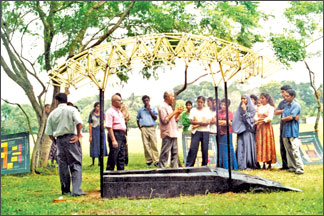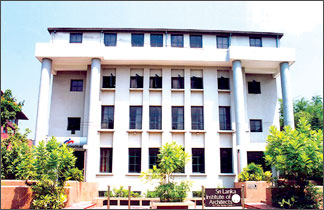|
Business Feature
Fifty years of architectural education
Ruwanthi Abeyakoon

Architecture students at a training programme

The Sri Lanka Institute of Architects building at Wijerama
Mawatha |
Architectural education in Sri Lanka spans for 50 long years. This
year Sri Lanka Institute of Architects (SLIA) celebrates their golden
jubilee on September 17. The history behind architectural education in
Sri Lanka cannot be over looked as it has bestowed several eminent
personalities to the society.
In 1961, the first professional level course in Architecture was
started at the Institute of Practical Technology. Until then there was
only a technical level course in Architecture conducted by the
Government Technical College.
Thus those interested in obtaining professional qualifications in
Architecture were compelled to travel to the UK or Australia.
The Ceylon Institute of Architects (Predecessor of the Sri Lanka
Institute of Architects) made significant contributions individually as
well as a collectively to raise the Standards of Architectural Education
to its present status.
Presently tertiary level courses are conducted at the University of
Moratuwa and also the Colombo School of Architecture.
The Board of Architectural Education (BAE) of the SLIA functions as a
body to educate young architects to acquire post-tertiary level
professional qualification.
The first few of the local private sector architectural practices
were established in the 1920s. One such practice was Adam & Small who
designed several buildings in the City of Colombo.
They designed the first section of the Lake House Building in early
1926. They were also the Architects for the Times of Ceylon Building
constructed in the Colombo Fort in 1936.
Architect Edward who was practicing in Madras established an
Architectural office in Colombo to design and supervise the Town Hall
Building and Architect H.H. Reid who was attached to the PWD joined
Edward in his practice.
The Public Works Department (PWD) of the Government of Ceylon,
recruited many architects in the 1920s to work on the new University
Project at Peradeniya. By 1935 several Ceylonese Architects had returned
to Ceylon after qualifying in England. Among them were H.J. Billimoria,
Fritz de Silva, Oliver Weerasinghe, and Herbert Gonsal.
During 1938 -1940, H. J. Billimoria joined the Government service as
the first Town Planner of the nation. By the late 1940s T. N.
Wynne-Jones, H. J. Billimoria and Justin Samarasekera were working for
the P.W.D., Oliver Weerasinghe and Neville Gunaratne for the Town
Planning Department, Wilson Peiris for the Colombo Municipality and K.
Jayatissa for the Department of Archaeology.
As there was no separate institute or association to represent
Architects, Architects Wynne-Jones, H. J. Billimoria and Justin
Samarasekera joined the Engineering Association. Wynne-Jones was an
Architect cum Structural Engineer from Wales.
He was also at one time the President of the Engineering Association
of Ceylon while H. J. Billimoria was the Secretary until his death in
1956. The first attempt to form an Institute of Architects was made in
1948 with Herbert Gonsal as the prime mover. Due to disagreement on some
issues, the matter was not pursued at that time.
Further attempts were made in 1951 and 1954 by Wynne-Jones with
Herbert Gonsal as the chief proponent. A number of meetings were held to
work out a constitution and in 1956 the Ceylon Institute of Architects
(CIA) was established by this small group of overseas qualified
Architects, who also had membership of the Royal Institute of British
Architects (RIBA).
The Inaugural meeting was held on September 11, 1957 at the Tea
Propaganda Board, Price Building, Prince Street, Fort, Colombo.
As Oliver Weerasinghe was due to take up an assignment in the United
Nations in a few months, Wynne-Jones requested Oliver Weerasinghe to
take the Chair and become the first President of the CIA.
Having adopted a constitution, which followed that of the British
Institute, the intention of the CIA was to obtain the status of an
allied society of the RIBA. They achieved this in 1960, by which time
the membership of The Ceylon Institute of Architects had risen to 30.
The CIA received the encouragement of the then President of the RIBA,
Sir Basil Spence and the considerable assistance of C. D. Spragg the
then Secretary of the RIBA. In recognition of this assistance Spragg,
was later elected by the CIA as its first Honorary Fellow.
Due to the hard work of these founder members of the Institute, a
School of Architecture attached to the Institute of Practical
Technology, Katubedda was established in 1961.
In 1976, through a private member’s motion by the then Minister of
Housing and Construction, Pieter Keuneman, the Ceylon Institute of
Architects was incorporated as the Sri Lanka Institute of Architects
(SLIA) by an Act of Parliament, called Sri Lanka Institute of Architects
Law No.1 of 1976.
After Incorporation, the Institute was called upon to perform
important public duties and to take responsibility for the education and
examination of architects for the purpose of providing a professional
qualification.
In order to improve the services offered to the members and public,
the Institute established a permanent office at the premises of the
SLAAS Building in April 1978.
Since then, the Institute has adopted Standing Orders, and a Code of
Conduct, and has established a Board of Architectural Education to serve
its members, the General Public and the construction industry of Sri
Lanka.
A long overdue amendment to the SLIA Law was presented to Parliament
in 1996 by the then Minister of Urban Development, Housing and Public
Utilities, Nimal Siripala De Silva.
The Sri Lanka Institute of Architects (Amendment) Law No. 14 of 1996
vested power in the Institute to form an “Architects Registration
Board”.
With the formation of this Board in February 1997 all those who
practice the profession of architecture in Sri Lanka are required to
register under three categories namely “Chartered Architects”,
“Architects”, and “Architectural Licentiates’.
One of the main objectives of the SLIA is to promote and advance the
study, practice and application of, and research in architecture and
kindred subjects, and the arts and sciences connected, therewith.
The Department of Architecture of the University of Moratuwa offers
both undergraduate and postgraduate courses in Architecture. The first
degree course, which is recognized by the SLIA and RIBA for exemption
from Part I of their Professional Examination is of three years full
time duration and leads to the BSc (Built Environment) degree.
This course is designed to provide a good foundation for advanced
studies and leads to several career prospects that relate to the built
environment, such as Architecture, Planning, Project Management,
Landscape Design and Architectural Conservation.
The Specialisation in the professional career structure arises out of
the postgraduate course in Architecture, which is of two years full time
duration and leads to the MSc (Architecture) Degree.
This degree is recognised by the SLIA and RIBA for exemption from
Part II of their Professional Examination.
By successfully completing this course a degree holder can prepare to
acquire full professional qualifications in Architecture from the SLIA
by passing Part III of its Professional Examination, the above degree
holders can eventually obtain the Overseas Membership of the RIBA.
This is a part - time lecture course to train students for Part I and
II of the Professional Practice Examinations of the SLIA.
The students are expected to work as apprentices in architectural
establishments registered as trainer establishments during their course
of study. Thereafter they have to work for one more year on a full time
basis before they sit Part III of the SLIA Professional Examination.
Over the years the course has become an avenue for persons who are
keen on studying architecture but are unable to obtain university
admission because of high competitiveness and limited number of places
available.
The course is in its 18th year and eight batches of students have so
far obtained professional qualifications since inception.
In 1999 the SLIA decided to establish a School of Architecture to run
the course. The school was named the Colombo School of Architecture
(CSA), and academic studies continue as a part time course with the same
apprenticeship -based educational structure under this new organization.
The school prepares students for the Professional Practice
Examinations conducted by the SLIA. The Lecture Course for Part III of
the SLIA Professional Examination is conducted directly by the BAE of
the SLIA.
At present architectural education has reached heights and the
students are employed all over the world.
The practice of architecture in the Asian Region is entering a new
era where dynamism in the approach to design with high-tech material and
technology is envisaged for the future.
The students are trained to be conscious of the fragile natural
environment, the socio-economic conditions related to the country and
the context of the built environment within which they are required to
design.
Sustainability of the environment is a criteria now built into the
design process, which requires the search for durability of
architectural systems, minimising the use of resources at construction
and manufacture of material, conservation of energy and designing for
flexibility.
The Department will align its teaching methods to encompass these
future needs and train the students to design for a sustainable
environment within a context appropriate to our country.
(Special thanks to Prof. Chitra Weddikkara, Dean, Faculty of
Architecture and Prof. Lal Balasuriya, Chartered Architect Urban
Designer and Professor of Architecture.)
Using astrology to manage your business -
Part 2
Dhammika Vitharanage
Contd. from last week
 Let us move on to see which Rashi (Houses) Lords would influence an
individual’s employment profile/prospects and his/her entrepreneurial
success/failures and to ascertain in which areas/directions his/her
employment or entrepreneurial success lies. Let us move on to see which Rashi (Houses) Lords would influence an
individual’s employment profile/prospects and his/her entrepreneurial
success/failures and to ascertain in which areas/directions his/her
employment or entrepreneurial success lies.
In ancient times, at the birth of a child, parents used to take this
new born child to the Rashi (if a Rashi existed) in order to get his/her
horoscope reading and the parents would go to an astrologer with the
time of birth to obtain a horoscope reading in days where a Rashi was
not present.
The Rashi or learned astrologer would then analyse the planetary
pattern and advice the parents about various facets of life like
education, profession, marriage, wealth, health etc., and on these lines
parents/elders would guide the child to attain his/her birth inherent
profession/vocation, may it be the case of ‘being employed by another’
type of person or ‘starting one’s own business type of person.
The astrologer further sub-dividing is able to advice on what kind of
a specific profession the ‘being employed by another’ should aim at i.e.
production, operational, sales, marketing, accounting, human resources,
management, legal etc. and for those who ‘start a business of their own’
the learned astrologer would provide guidance as to which field they
should follow to commence their own business i.e. when the planet Venus
is strong, the Entertainment and Hospitality trade is a field in which
he/she would be successful in and when planet Saturn is strong the
Medical/Healthcare sectors would be the best chosen field for one’s
success.
 Before proceeding further, it is strongly emphasised that all these
are generic statements on business astrology and would difer on an
individual/personal basis and strongly emphasise that these theories
would apply to all in a consistent manner. Before proceeding further, it is strongly emphasised that all these
are generic statements on business astrology and would difer on an
individual/personal basis and strongly emphasise that these theories
would apply to all in a consistent manner.
It would differ due to planetary permutations/combinations of each
individual and this is when the service of a competent astrologer is
needed.
It is a generally known fact that whatever the religion or
nationality may be, each individual has a star Sign (Lagnaya) and that
sign has a ruler or the in charge or the fatherly planet.
Taking a look at that planet first would assist to gauge the nature
and extent of an individual’s success in all aspects of life.
If the sign (Lagna) Lord is well placed and strongly positioned then
he/she would be successful in their respective field whether engaged in
employment or owning a business i.e. Lagna Lord placed on the 10th house
is generally considered as being good although not necessarily being a
hard and fast rule as these differ according to planetary
permutations/combinations of each individual as mentioned previously.
The power of the Lagna Lord provides the fundamental pillar support
for an individual to succeed or fail in his/her profession vocation or
in a own business.
Simply the name fatherly planet gives us the whole comprehensive
meaning as in ordinary human life.
 If a person’s father is educated, wealthy and powerful then the child
would enjoy the benefits of his/her father’s accumulations and would
have a hassle free life and on the other hand, if a person’s father was
an uneducated, poor layman, the child would have to undergo hardships in
life. If a person’s father is educated, wealthy and powerful then the child
would enjoy the benefits of his/her father’s accumulations and would
have a hassle free life and on the other hand, if a person’s father was
an uneducated, poor layman, the child would have to undergo hardships in
life.
The same rule applies to the Lagna Lord (fatherly planet) principle.
Although we mentioned a Lagna Lord (fatherly planet), we are yet to
explain the theory of signs and their respective fatherly planets. There
are only 12 signs and all humans fall within these 12 signs.
Further, there are 7 material (tangible) planets and 2 non-material
(intangible) planets but only the 7 material planets can act as lagna
Lords.
The other two non-material planets (Rahu and Kethu) do not fall into
the category of Lagna Lords.
Seminar on how to conduct business in today’s environment
The Ceylon Chamber of Commerce, in cooperation with the Confederation
of Asia-Pacific Chambers of Commerce and Industry, will conduct a
seminar on “How to conduct business in today’s environment” tomorrow at
the Longdon Room, Hotel Taj Samudra.
Today’s global economic environment poses many challenges for
business to succeed. There are many policy changes, both local and
international which affect business.
There is the push for liberalisation and globalisation with the new
focus on social responsibility, and the emphasis for green products,
rapid development in new technology calling for business innovation, and
e-Commerce, among others, all requiring serious consideration in
business planning and execution.
One must adopt financial strategies to cope with today’s credit risks
management. The seminar discusses some pitfalls and potential land mines
in today’s business environment.
The stakes are indeed high. While there are challenges there are also
new opportunities for business. The speakers will take up practical
approaches to deal with both challenges and opportunities.
The speakers include an academician who keeps up with today’s
challenges and a business entrepreneur who also plans to offer joint
venture opportunities during his presentation.
They will both interact with participants on the topics to be
discussed to give the seminar a practical and innovative approach in
facing the challenges and to succeed in today’s business environment.
Leoncio Cubillas, is a consultant and trainer from the University of
the Philippines, a renowned state university in the Philippines. He
specialises in Entrepreneurship Development and Planning, Production,
Marketing, Entrepreneurial Finance, Feasibility Studies, and Technology
Assessment, among others.
He has participated in seminars on Entrepreneurship for Planning and
Development in Dhaka, Bangladesh; Brunei Darussalam; Peshawar, Pakistan;
and Kuala Lumpur, Malaysia. He is a consultant of the World Bank, Swiss
Development Agency for Cooperation and also faculty affiliate of the
Ateneo Graduate School of Business.
Gonzalo Catan is not only a successful businessman but also an
inventor. He has accumulated a lot of awards. He is a B.S. in
Agriculture with major in Entomology and Minors in Chemistry and Plant
Pathology.
The seminar will also feature a successful Sri Lankan entrepreneur,
Chairman of KIK Group of Companies Lalith Kahatapitiya, who will address
participants on “The changing policies at home that can offset business
and how local businesses are coping with these policies”. |

